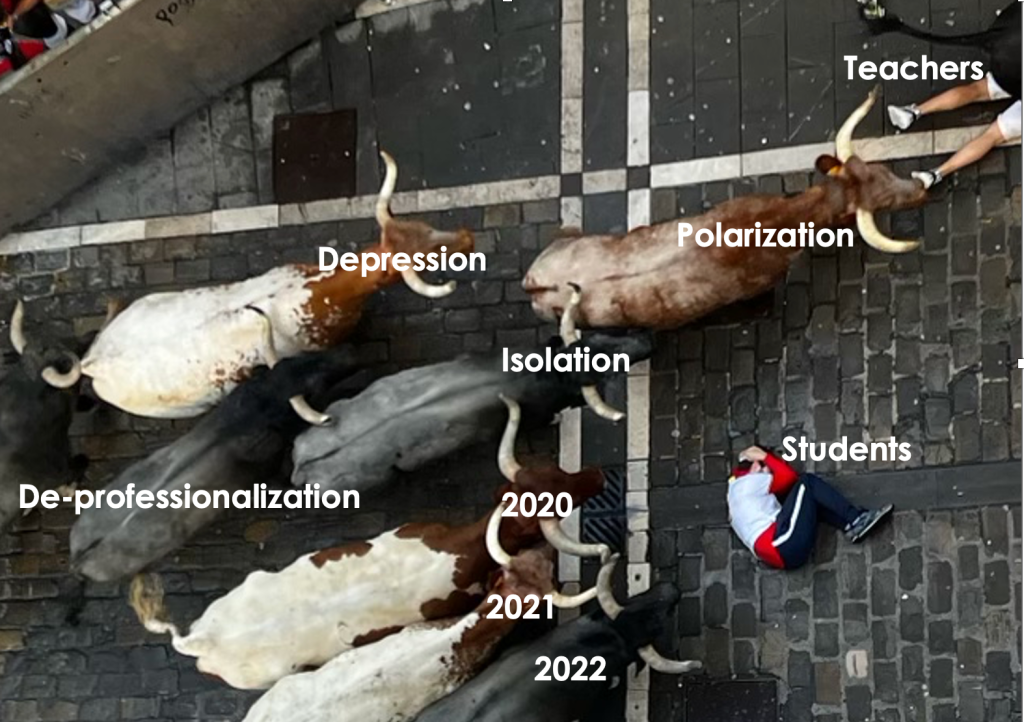Getting Back to Basics
As the pandemic wanes, teachers can prioritize attending to three essentials in the classroom: feedback, engagement, and well-being.
Your content has been saved!
Go to My Saved Content.Running with 1,500-pound horned animals through narrow streets might be a cultural event that has been occurring for over 500 years, but it seems unwise. I realized this as I was chasing my 19-year-old son through the streets of Pamplona, Spain, jumping over terrorized runners who had fallen to the ground, with the sounds of hooves on cobblestones pounding in my ears. This is what dads do when they cannot talk their sons out of what they see as an epic adventure.
When I saw the picture (below) that my wife had captured (neither my son nor I ever ended up on the ground), I was struck by the fact that this is how the last three years have felt to many educators and students.

We’ve been trampled by 2020, 2021, and 2022, through polarization, isolation, depression, and de-professionalization as we try to find bodies to fill teaching positions, from military veterans without certification to teachers who have not completed college degrees.
Where do we find hope? Where do we find answers? We go back to basics to survive and then thrive. Teaching is about attending to three essential elements: feedback, engagement, and well-being (FEW).
As I write in my book, Just Teaching: Feedback, Engagement, and Well-Being for Each Student, we employ these elements—not for some students or even all students, but for each student. As educators, we need to be sure that we’re using these three elements for ourselves and others as well. The good news is that they can be mutually reinforcing.
Feedback
Feedback is one of the most time-consuming tasks for any educator. How do we provide meaningful feedback that will actually improve student work?
No one wants to be judged. We all want to improve. Give honest feedback, therefore, that focuses on improvement. Assessment comes from a Latin root word that means “to sit beside.” Quality feedback is the result of our sitting beside students and colleagues. If we give feedback throughout the process, rather than only at the end, the feedback can lead to meaningful improvement.
Ensure clear criteria and invite peer feedback with parameters. In a typical classroom, we have 20 to 30 potential feedback partners. We just need to give student peers clear criteria for success so that they can advise other students on their progress toward their goals.
Provide flash feedback. In his book Effortless, Greg McKeown writes, “Not everything requires the extra mile.” If we are overwhelmed by giving feedback, we can almost certainly assume that our students are overwhelmed. We don’t need to give feedback on everything. We can focus feedback on one to two attributes of the work. Providing timely, targeted feedback is easier to give and receive.
Engagement
How do we create opportunities for full engagement for our students in safe learning environments?
Content: We need content that’s relevant, challenging, and accessible. This is one of the biggest challenges with scripted curriculum that treats individual classrooms with unique students as cookie-cutter problems to be solved. Effective teachers find ways to connect content to the lives of their students.
Consolidation: Students need the opportunity to review and synthesize content so that they can internalize skills and knowledge. This can be through games, writing, discussion, or any number of methods that require students to retrieve previously learned content.
Collaboration: A primary driver of consolidation is collaboration. As students work together, they develop empathy and appreciation of different perspectives. This leads to deeper understanding and better outcomes for more students.
Creation: We want students to generate new ideas and new thinking based on engaging content. When students own their learning and begin to generate innovative approaches, we know they’re fully engaged.
Well-being
Feedback and engagement can contribute to well-being, but they’re not possible if educators and students aren’t well.
See each student (not some or even all). When we start seeing individuals in our classrooms, teaching becomes infinitely interesting. Each student brings a unique story and perspective each day, enriching and enlivening our classrooms with their viewpoints. One easy way to see each student is to let them know when we don’t see them there. A high school English teacher shared with me that she records a quick message with her students at the beginning of class and sends it to those who are absent to let them know they were missed.
See each educator. Sometimes we spend so much time understandably focused on our students that we miss seeing our fellow educators. Here’s a quick question to gauge how well you’re seeing others around you: What colleague’s idea have you voluntarily supported recently? If you have to spend a lot of time thinking about this, then look for someone’s idea to support today. Catalytic leaders support and celebrate the leadership of others.
Intentional relationships undergird all three essential elements of teaching as we support other educators and students so they can flourish.
My son and I survived our run, but our students and colleagues can do so much more than survive if we attend to these FEW crucial elements.


